We believe it is best to get this out of the way upfront: not all closures are made the same. No one type is better or worse than another, they – like humans – are just different. It takes all kinds.
That said, let’s take a look at the different types of closures.
 Natural Cork: Going as far back as the Greeks, the Quercus suber (cork oak) has been used for plugging up countless vintages of the nectar of the gods. The quality levels for natural corks start with “Flor” which has no surface imperfections, maybe just a line or two that are visible. From there it goes: Extra, Super, First, Second, Third…all the way down to Seventh (then Reject). Generally speaking, anything below Third has its imperfections filled with cork dust or becomes broken down to be recycled into granules or made into smaller corks for other applications outside of wine. Natural corks are perfect for aging wines as they allow the perfect amount of oxygen to interact with the wine during the aging process and can form with irregularities in the glass neck of a bottle to seal more completely.
Natural Cork: Going as far back as the Greeks, the Quercus suber (cork oak) has been used for plugging up countless vintages of the nectar of the gods. The quality levels for natural corks start with “Flor” which has no surface imperfections, maybe just a line or two that are visible. From there it goes: Extra, Super, First, Second, Third…all the way down to Seventh (then Reject). Generally speaking, anything below Third has its imperfections filled with cork dust or becomes broken down to be recycled into granules or made into smaller corks for other applications outside of wine. Natural corks are perfect for aging wines as they allow the perfect amount of oxygen to interact with the wine during the aging process and can form with irregularities in the glass neck of a bottle to seal more completely.
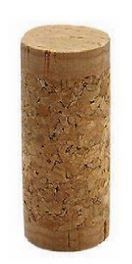 Double Disc Cork a.k.a. 1+1: If you’re wondering where all the granules from Fourth through Seventh go, here is one place you will find them. The 1+1 utilizes a laminated cork disc on the two ends while the center is filled with a combination of natural cork grains and agglomerated cork. This combination actually makes for a cork that is more durable, and less penetrable than natural cork. These, like natural cork, are for aging wines.
Double Disc Cork a.k.a. 1+1: If you’re wondering where all the granules from Fourth through Seventh go, here is one place you will find them. The 1+1 utilizes a laminated cork disc on the two ends while the center is filled with a combination of natural cork grains and agglomerated cork. This combination actually makes for a cork that is more durable, and less penetrable than natural cork. These, like natural cork, are for aging wines.
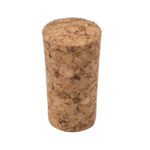 Agglomerated Cork: Created by the combination of unusable cork materials (cork bark and Fourth through Seventh corks ground down), cork dust, and food safe binders. These corks are used in wines that are meant to be drank within their first year of release and are not for aging wines. They create a wonderful seal that is as just as moldable to imperfections in the neck of a bottle but will not keep enough oxygen at bay for long term aging. The upside is their ability to take a young wine and let it develop naturally to its potential in a year’s time.
Agglomerated Cork: Created by the combination of unusable cork materials (cork bark and Fourth through Seventh corks ground down), cork dust, and food safe binders. These corks are used in wines that are meant to be drank within their first year of release and are not for aging wines. They create a wonderful seal that is as just as moldable to imperfections in the neck of a bottle but will not keep enough oxygen at bay for long term aging. The upside is their ability to take a young wine and let it develop naturally to its potential in a year’s time.
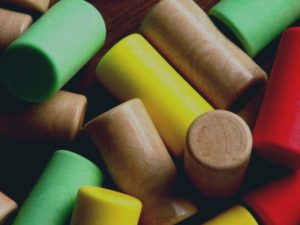 Synthetic Cork: Synthetic corks somewhat still have the Jury out on them, but they are very durable, keep the wine from being introduced to bacteria, and allow the perfect amount of oxygen to interact with the wine. They are generally petroleum-based plastic, and they come in a wide variety of colors which make for great marketing options. The down side to these corks is said to be a “chemical” taste to the wines, but as stated, the Jury is still out, as there is no scientific proof on this matter. On average, these closures can keep a wine safe for 1-3 years and you have no risk of your wine being “corked” a.k.a. cork taint.
Synthetic Cork: Synthetic corks somewhat still have the Jury out on them, but they are very durable, keep the wine from being introduced to bacteria, and allow the perfect amount of oxygen to interact with the wine. They are generally petroleum-based plastic, and they come in a wide variety of colors which make for great marketing options. The down side to these corks is said to be a “chemical” taste to the wines, but as stated, the Jury is still out, as there is no scientific proof on this matter. On average, these closures can keep a wine safe for 1-3 years and you have no risk of your wine being “corked” a.k.a. cork taint.
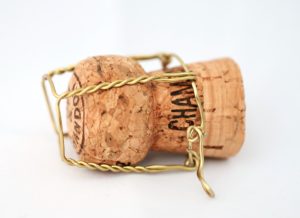
Champagne Cork: The average bottle of the party starter contains 1 million bubbles and above the pressure of the average car tire! These liquid delights require a whole ‘nother level of closure. Champagne corks are always produced from high quality compressed cork to counter the pressure against them and housed with a cage to assure the closure will withstand most movement (but never a full shake). As it has been reported a number of times from the Daily Mail website, “More people are killed each year by flying Champagne corks than bites from poisonous spiders. Of the nearly two dozen Champagne-accident fatalities a year, more than a third occur at weddings.” So, please, always be mindful of the cork when opening a bottle of bubbles.
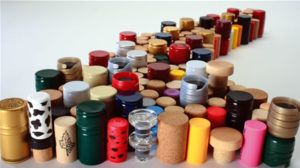 Other Closures: There is a long, growing list of closures for wines beyond the traditional or synthetic styled corks. Screw Caps, VinoLok, Zork, Helix…the list goes on, and continues to grow. Of all the listed types, the only one that has been around long enough to hold weight is the Screw Cap. Some will argue for its potential to age, some will argue against. VinoLok (a glass closure with a seal) has had some good traction thus far, but it like the other alternative corks listed, they are too new to tell. Here we find ourselves back at the beginning, for it is fair to say that all closures are not the same, and in a literal sense, it takes all kinds.
Other Closures: There is a long, growing list of closures for wines beyond the traditional or synthetic styled corks. Screw Caps, VinoLok, Zork, Helix…the list goes on, and continues to grow. Of all the listed types, the only one that has been around long enough to hold weight is the Screw Cap. Some will argue for its potential to age, some will argue against. VinoLok (a glass closure with a seal) has had some good traction thus far, but it like the other alternative corks listed, they are too new to tell. Here we find ourselves back at the beginning, for it is fair to say that all closures are not the same, and in a literal sense, it takes all kinds.

